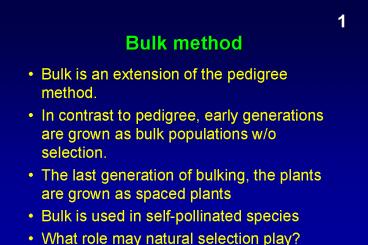Bulk method - PowerPoint PPT Presentation
1 / 20
Title:
Bulk method
Description:
Generally used in crosses with exotic germplasm ... Exotic Donor' parent. 16. Implementation. P1 Adapted parent x P2 Donor parent' ... Incorporate 'exotic germplasm' ... – PowerPoint PPT presentation
Number of Views:387
Avg rating:3.0/5.0
Title: Bulk method
1
Bulk method
1
- Bulk is an extension of the pedigree method.
- In contrast to pedigree, early generations are
grown as bulk populations w/o selection. - The last generation of bulking, the plants are
grown as spaced plants - Bulk is used in self-pollinated species
- What role may natural selection play?
2
Requirements
2
- Two parents
- Complementary in strengths and weaknesses
- AAbb x aaBB
3
Implementation
3
- 3n genotypes in F2 reduced to 2n homozygotes
- Natural selection during bulk phase
- Theoretically, natural selection may result in
poor genotypes contributing relatively fewer
seeds to the next generation - At F5 or F6 space plant for preliminary yield
evaluations
4
Bulk
4
F1
Bulk w/o selection
F2
F3
Bulk w/o selection
space plant
Fn
Select among inbred lines
5
Features of Bulk method
5
- Inbreeding and evaluation of inbred lines
- Should bulking be done in production environment?
Natural selection? - Little record keeping
- Easy to handle populations - harvest in bulk
- Extensive field trials not required
6
Negative features
6
- Maximum productivity is established in F2
generation - No recombination among superior lines
- Objective is an array of inbred lines which have
been inbred from an F2 population, but, how
natural selection, migration, mutation and drift
may have shifted the population is unknown.
7
Single Seed Descent
7
- Called Recombinant Inbred Lines in molecular
marker literature - First suggested by Goulden in 1939 and later
expanded upon by Brim (a soybean breeder) in
1966.
8
SSD -Requirements
8
- Two parents crossed to produce F1
- Exactly like pedigree and bulk
9
Implementation
9
- Objective is rapid inbreeding to evaluate inbred
lines - Easy way to maintain populations
- Often minimum space required
- Inbreeding can be done in greenhouse or winter
nursery
10
SSDsystematic inbreeding w/o selection
10
F2
F3
Fn
Select among inbred lines
11
Features of Single seed descent
11
- Inbreeding and evaluation of inbred lines
- Little record keeping
- Easy to handle populations - extensive field
trials not required - Final lines represent a truesample of variation
12
Negative features of SSD
12
- Maximum productivity is established in F2
generations - No recombination among selected lines
- Must evaluate large numbers of inbred lines to
identify superior ones - Little opportunity for early generation
selection, as inbreeding may be done in
greenhouse or winter nursery
13
13
ComparisonAll result in an array of inbred lines
Pedigree
Bulk
SSD
Systematic process to insure that inbred lines
represent balanced sample
Select among and within during
inbreeding
No selection, assume genes will remain at same
frequency
14
14
Pedigree, Bulk and SSD How do they differ in
terms of distribution of inbred lines ?
15
Inbred Backcross
15
- Combines features of Backcross and SSD
- Generally used in crosses with exotic germplasm
- The goal is to identify major genes involved in
quatitative variation (Wehrhan and Allard,
Genetics 1965, 51109-119. - Develop inbred lines with an array of variation
for the quatitative trait
16
Requirements
16
- Two parents
- Desirable Recurrent parent
- Exotic Donor parent
17
Implementation
17
- P1 Adapted parent x P2 Donor parent
- BC1 (P1 x F1) 25 exotic
- BC2 (P1 x BC1) 12.5 exotic
- BC3 (P1 x BC2) 6.25 exotic
- Thus, BC before initiating SSD
18
BC, then inbreed via SSD
18
19
Features of IBC
19
- Incorporate exotic germplasm
- Final evaluation based on inbred lines that
represent a range of variation for quantitative
trait. - Can be done in GH or winter nursery
20
Negative features of IBC
20
- Maximum productivity is established in BC
generations - No recombination among lines
- Little opportunity for selection
- Often used in genetic studies vs. breeding
- Must evaluate many inbred lines































